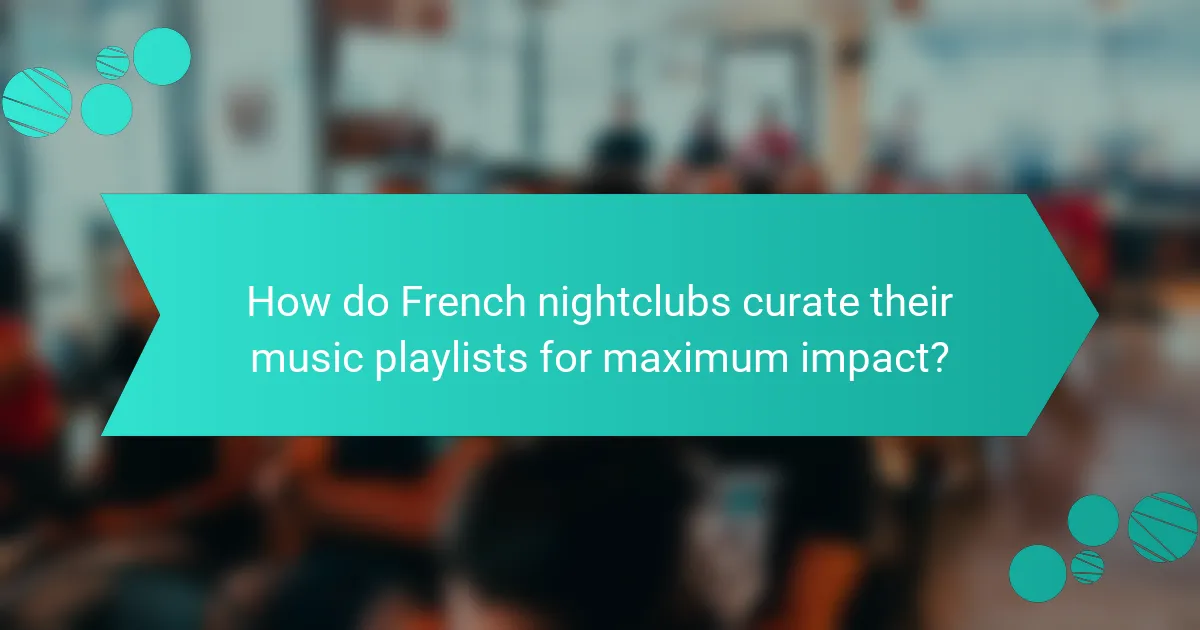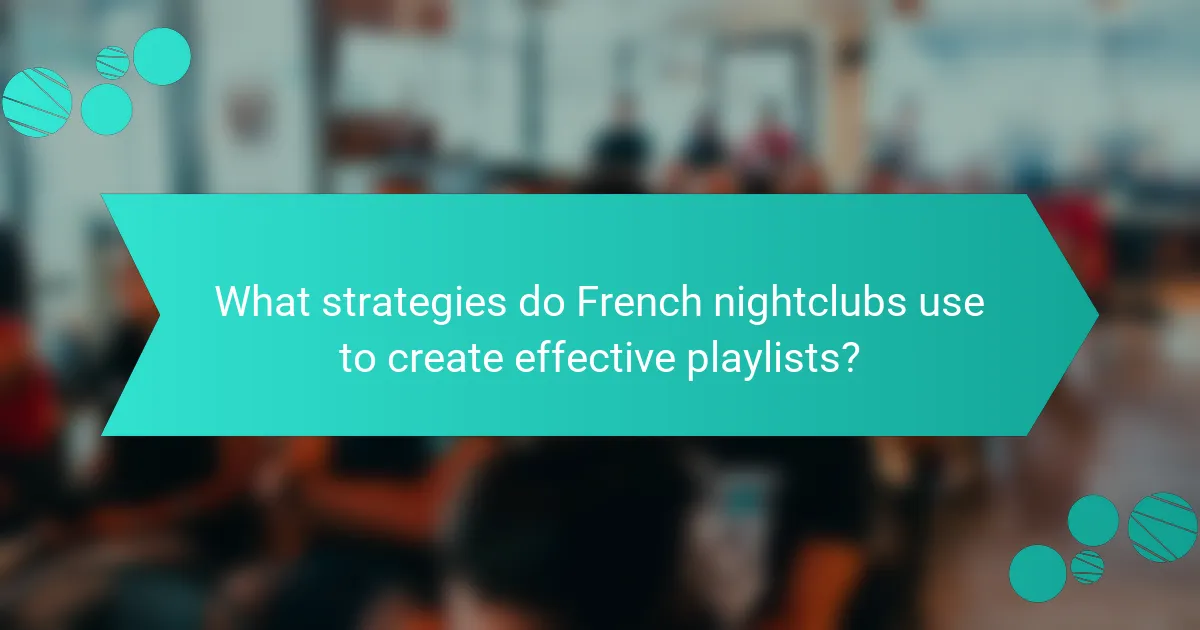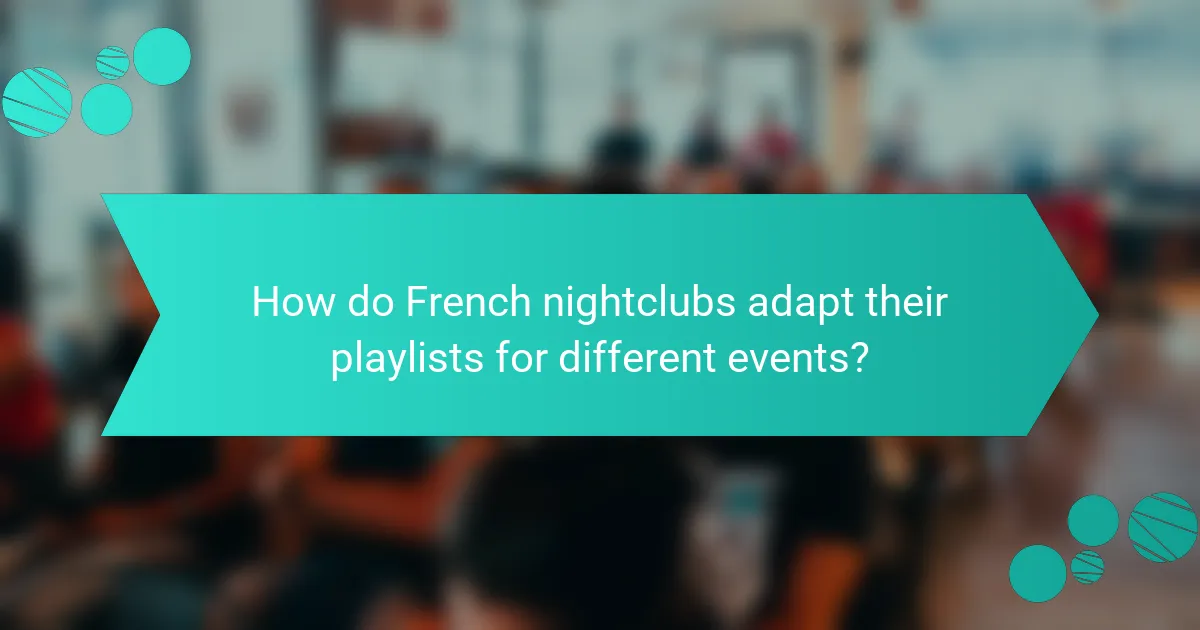French nightclubs utilize a variety of strategies to curate their music playlists, focusing on crowd dynamics and musical trends to enhance the guest experience. DJs monitor audience reactions and adjust playlists in real-time, incorporating a mix of popular and underground tracks that align with seasonal trends and event themes. Data analytics tools play a crucial role in tracking song popularity and audience preferences, while collaborations with local artists add uniqueness to the music selection. By considering factors such as event type and timing, nightclubs aim to maintain energy levels and create an engaging atmosphere for patrons.

How do French nightclubs curate their music playlists for maximum impact?
French nightclubs curate their music playlists by analyzing crowd dynamics and musical trends. DJs often observe the audience’s reactions to different genres and tempos. They adjust the playlist in real-time to maintain energy levels. Data analytics tools are also used to track popular tracks and emerging artists. This helps in selecting music that resonates with patrons. Additionally, many clubs feature themed nights that influence the music selection. Collaborations with local artists can enhance the uniqueness of the playlist. The goal is to create an immersive experience that keeps guests engaged and dancing.
What factors influence the music selection in French nightclubs?
Music selection in French nightclubs is influenced by several key factors. The target demographic plays a crucial role in determining music genres and styles. DJs often tailor their playlists to match the preferences of the crowd present. Additionally, current music trends impact the choices made by DJs and club managers. The time of night also affects music selection, with different tempos and styles being appropriate for various hours. Venue branding influences the type of music played, aligning with the club’s overall theme and atmosphere. Special events or guest DJs can lead to unique music selections that differ from regular programming. Finally, cultural influences, such as regional music styles, contribute to the diversity of playlists in French nightclubs.
How does the venue’s atmosphere affect playlist choices?
The venue’s atmosphere significantly influences playlist choices. A lively atmosphere typically encourages upbeat and energetic music selections. Conversely, a relaxed environment often leads to softer, more mellow tracks. The type of crowd present also plays a crucial role. For instance, a sophisticated crowd may prefer more refined genres like jazz or lounge music. Research shows that music tempo can affect patrons’ moods and behaviors, impacting their overall experience. Additionally, the venue’s lighting and decor can shape the emotional tone of the music played. Ultimately, the alignment of music with the venue’s atmosphere enhances guest satisfaction and engagement.
What role do DJ preferences play in music curation?
DJ preferences significantly influence music curation in nightclubs. DJs select tracks that resonate with their personal taste and style. This selection shapes the overall atmosphere of the venue. Their choices can enhance audience engagement and enjoyment. Research shows that a DJ’s unique sound can attract specific crowds. For example, a DJ known for techno may curate a playlist that reflects that genre. This targeted approach fosters a loyal following. Ultimately, DJ preferences help create a distinct identity for the nightclub. This identity can differentiate the venue in a competitive market.
Why is music curation important for the nightclub experience?
Music curation is essential for the nightclub experience because it shapes the atmosphere and influences patrons’ emotions. A well-curated playlist keeps energy levels high and encourages dancing. It also creates a unique identity for the nightclub, differentiating it from competitors. Research shows that specific genres and tempos can enhance social interactions and enjoyment. For instance, a study found that upbeat music increases the likelihood of people staying longer and spending more. Additionally, music curation allows DJs to respond to the crowd’s mood, ensuring an engaging experience. Overall, effective music curation significantly enhances the overall enjoyment and success of the nightclub environment.
How does music influence the mood and energy of clubgoers?
Music significantly influences the mood and energy of clubgoers. It sets the atmosphere and can elevate emotions. Upbeat tracks often create excitement and encourage dancing. Slower songs may evoke introspection or relaxation. Research shows that specific tempos can affect heart rates and energy levels. For instance, songs with a tempo of 120-130 BPM are commonly used in clubs to enhance energy. Additionally, music genres like house and techno are known for their energizing effects. This correlation between music and mood is why nightclubs carefully curate playlists.
What are the psychological effects of music on dance and social interaction?
Music significantly influences psychological responses during dance and social interaction. It enhances mood and promotes feelings of happiness. Studies show that rhythmic music can synchronize movements, leading to increased coordination in dance. This synchronization fosters social bonding among participants. Additionally, music can reduce social anxiety, making individuals more open to interaction. Research indicates that upbeat tempos encourage more energetic dance styles, which can enhance group dynamics. Furthermore, music creates a shared emotional experience, strengthening connections between dancers. The psychological effects of music are crucial in nightclub environments, where curated playlists aim to maximize social engagement and enjoyment.

What strategies do French nightclubs use to create effective playlists?
French nightclubs use a variety of strategies to create effective playlists. They analyze crowd dynamics to understand peak times and energy levels. DJs often adjust their sets based on real-time audience reactions. They incorporate a mix of popular tracks and underground music to maintain interest. Seasonal trends influence song selection, aligning with current musical movements. Collaborations with local artists enhance authenticity and connection. Technology tools help in tracking song popularity and audience preferences. These strategies aim to create an engaging and memorable experience for club-goers.
How do nightclubs balance popular tracks with unique selections?
Nightclubs balance popular tracks with unique selections by strategically curating their playlists. They incorporate mainstream hits to attract a larger audience. Popular tracks create an immediate connection with the crowd, enhancing the overall energy. Unique selections provide a distinctive experience that sets the nightclub apart. This approach keeps the music fresh and engaging for regular patrons. Many nightclubs analyze crowd reactions to refine their playlists. They often use data from previous events to identify successful combinations. By blending familiar songs with lesser-known tracks, nightclubs maintain a dynamic atmosphere that appeals to diverse tastes.
What is the significance of mixing genres in a nightclub setting?
Mixing genres in a nightclub setting enhances the overall experience for attendees. It creates a dynamic atmosphere that encourages diverse dance styles. This diversity attracts a broader audience, increasing foot traffic and revenue. Research shows that varied music keeps patrons engaged longer. According to a study by the University of California, mixing genres can elevate mood and energy levels. This leads to increased social interaction among guests. Ultimately, genre mixing fosters a unique identity for the nightclub. This identity can differentiate it from competitors in a crowded market.
How do nightclubs incorporate local music into their playlists?
Nightclubs incorporate local music into their playlists by featuring regional artists and sounds. They often collaborate with local musicians to create a unique atmosphere. This strategy enhances the connection with the local community. Nightclubs may also host events that spotlight local talent. These events help promote the artists while attracting patrons. Additionally, DJs are encouraged to include local tracks in their sets. This practice showcases the diversity of the local music scene. Research indicates that local music can increase customer engagement and loyalty. Nightclubs benefit from this approach by fostering a sense of belonging among attendees.
What role does technology play in music curation for nightclubs?
Technology plays a crucial role in music curation for nightclubs. It enables DJs to access vast music libraries instantly. Digital platforms allow for real-time updates to playlists. Software tools assist in analyzing crowd reactions to different tracks. This data helps DJs make informed decisions about song selections. Additionally, algorithms can suggest tracks based on previous successful mixes. Many nightclubs utilize lighting and sound systems that sync with music selections. This enhances the overall experience for patrons.
How do music streaming services impact playlist development?
Music streaming services significantly influence playlist development. They provide algorithms that recommend songs based on user preferences. These algorithms analyze listening habits to curate personalized playlists. Additionally, streaming platforms allow DJs and curators to access vast libraries of music. This access enables them to experiment with diverse genres and styles. Data from services like Spotify shows that curated playlists drive user engagement. For instance, Spotify’s “Discover Weekly” playlist has millions of active users, showcasing its impact on music discovery. Streaming services also facilitate collaboration among artists, leading to innovative playlist curation. Overall, these platforms shape how playlists are created and consumed in nightlife settings.
What tools do DJs use to analyze crowd reactions to music?
DJs use various tools to analyze crowd reactions to music. These tools include software applications, hardware devices, and audience feedback systems. DJ software like Serato and Traktor provides real-time analytics on track performance. Some DJs utilize visual aids, such as LED screens, to gauge audience engagement. Mobile applications allow DJs to receive instant feedback from attendees. Additionally, social media platforms enable DJs to monitor audience reactions online. Crowd-sourced data from these tools helps DJs adjust their playlists dynamically. Research shows that understanding crowd reactions enhances the overall nightclub experience. This data-driven approach is essential for curating impactful music playlists.

How do French nightclubs adapt their playlists for different events?
French nightclubs adapt their playlists for different events by considering the theme and audience. Each event type, such as a fashion show or a holiday celebration, influences the music selection. DJs often curate sets that match the energy level expected at the event. For instance, high-energy tracks are chosen for dance parties, while more relaxed music suits cocktail events.
The timing of the event also plays a role. Early evenings may feature softer tunes, transitioning to upbeat tracks later. Additionally, crowd feedback can guide playlist adjustments in real-time. Nightclubs may also incorporate popular tracks to align with current trends. This strategy ensures that the music resonates with attendees, enhancing their overall experience.
What considerations are made for themed nights or special events?
Themed nights or special events in French nightclubs require careful planning. Considerations include the target audience and their musical preferences. Nightclubs analyze demographic data to tailor experiences. Venue decor must align with the theme to enhance ambiance. Special promotions or drink menus often complement the event’s concept. Scheduling guest DJs or live performances is crucial for engagement. Marketing strategies should effectively promote the event to attract attendees. Feedback from previous events helps refine future themed nights.
How do seasonal trends affect music selection in nightclubs?
Seasonal trends significantly influence music selection in nightclubs. During summer, upbeat and danceable tracks dominate playlists. This aligns with the vibrant atmosphere and outdoor events typical of the season. In winter, the focus shifts to more mellow and cozy genres. Cold weather prompts a preference for music that creates an intimate ambiance.
Research indicates that patrons’ moods change with the seasons. For example, a study published in the Journal of Consumer Research highlights how environmental factors impact music preferences. Additionally, nightclubs often curate playlists to reflect seasonal themes or holidays. This enhances the overall experience and keeps patrons engaged.
What strategies are used for catering to diverse audiences?
French nightclubs employ several strategies to cater to diverse audiences. They curate music playlists that reflect various genres and cultural influences. This approach ensures that different demographic groups feel represented. Nightclubs often analyze audience preferences through surveys and social media engagement. They also collaborate with local artists to incorporate regional music styles. Additionally, themed nights are organized to celebrate specific cultures or music genres. By diversifying their offerings, nightclubs enhance the overall experience for all attendees. This strategy increases customer satisfaction and encourages repeat visits.
What best practices can be followed for effective music curation in nightclubs?
Effective music curation in nightclubs involves understanding the audience, maintaining energy flow, and selecting diverse tracks. Nightclubs should analyze crowd reactions to tailor playlists. Observing peak times helps in choosing high-energy tracks. Incorporating various genres can keep the atmosphere dynamic. Regularly updating playlists ensures freshness and relevance. Collaborating with local artists can enhance community engagement. Utilizing technology for data-driven insights improves track selection. These practices contribute to an engaging nightlife experience.
How can DJs improve their playlist curation skills?
DJs can improve their playlist curation skills by analyzing audience reactions and adapting to the vibe. They should observe how the crowd responds to different tracks. This feedback helps in selecting songs that resonate well. Additionally, DJs can study successful playlists from renowned clubs. Research shows that playlists with a mix of genres maintain audience engagement. Using data analytics tools can also provide insights into popular tracks. DJs should regularly update their playlists to include fresh music. Networking with other DJs can facilitate the exchange of ideas and techniques. Engaging with listeners through social media can provide valuable feedback on preferences.
What tips can nightclub managers implement for successful music programming?
Nightclub managers can implement several tips for successful music programming. First, they should analyze the target audience’s preferences. Understanding the demographic helps tailor the music selection. Second, creating a balanced playlist is essential. A mix of genres and tempos keeps the energy flowing. Third, scheduling music for peak hours enhances the experience. Research shows that specific tracks can boost patron engagement during busy times. Fourth, collaborating with local DJs can bring fresh perspectives. Local talent often resonates well with the community. Lastly, regularly updating the playlist keeps the atmosphere dynamic. Studies indicate that patrons are more likely to return when they encounter new music.
The main entity of this article is French nightclubs and their music curation practices. The article explores how these nightclubs strategically develop playlists to enhance the guest experience by analyzing crowd dynamics, musical trends, and demographic preferences. Key factors influencing music selection include venue atmosphere, DJ preferences, and the incorporation of local music. Additionally, the article discusses the role of technology in playlist development, the significance of mixing genres, and best practices for effective music programming. Overall, it highlights the importance of music curation in creating an engaging and memorable nightclub environment.